Your Tattoo Pain Guide: Least To Most Painful Placements, Ranked
Your Tattoo Pain Guide: Least To Most Painful Placements, Ranked
Enjoying the lifelong pleasure of a tattoo inevitably comes with some temporary pain. Do tattoos hurt? You know the answer is “yes” – whether you’re getting your first tattoo or have gotten inked a few times before. However, asking the question “How bad do tattoos hurt?” is a more helpful and nuanced question, which requires some context and individualized considerations to appropriately answer. Like any type of real estate, the location of your tattoo makes all the difference when it comes to how painful the experience will most likely be. The pain you experience when getting a tattoo also depends on your biological sex, the size of the tattoo, your skin’s sensitivity, personal pain tolerance, the client’s stress levels during the tattooing process, the artist’s skill experience and level and whether you decide to use a tattoo numbing cream, like Zensa Numbing Cream, before getting for your tattoo.
Expert Tip: Zensa Numbing Cream contains 5% lidocaine for maximum-strength pain prevention without compromising pigment retention. Our unique formula does not contain any vasoconstrictors, so Zensa Numbing Cream will not temporarily change your skin’s texture or negatively affect ink settling (the main reason any experienced tattoo artist might be hesitant to use a topical anaesthetic). Zensa Numbing Cream’s numbing effects last for 2-3 hours and can be reapplied on broken skin. Our natural pH formula is suitable for sensitive areas and contains vitamin E to soothe inflammation and minimize any pain or soreness you experience after getting your tattoo.
Read on to learn more about:
-
The least painful and most painful spots to get a tattoo
-
Where different placements rank on the tattoo pain scale from 1-10
-
Determinants that affect how much your tattoo will hurt, and
-
How to find tattoo pain relief before and after getting inked
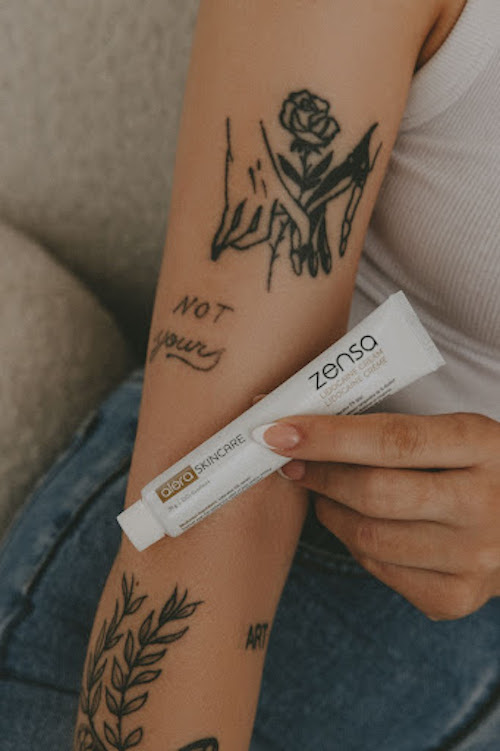
The placement of your tattoo, your biological sex, age, weight, body composition/shape and personal pain tolerance all determine where it will be the most painful spots to get a tattoo. Generally speaking, the most painful places to get a tattoo will be on the boniest areas of the body or placements that sit over concentrated hubs of nerve endings. It will hurt less to get a tattoo on the areas where there is less body fat, more muscle or fewer nerve endings. The most painful tattoo placements are frequently located at the extremities (head, face, hands, fingers, feet, toes), regions where there is naturally less body fat (ribcage, shoulder blade, collarbones, hips, ankles) or more nerve endings (armpit, groin or buttocks).
Tattoo Pain Chart (Female vs. Male)
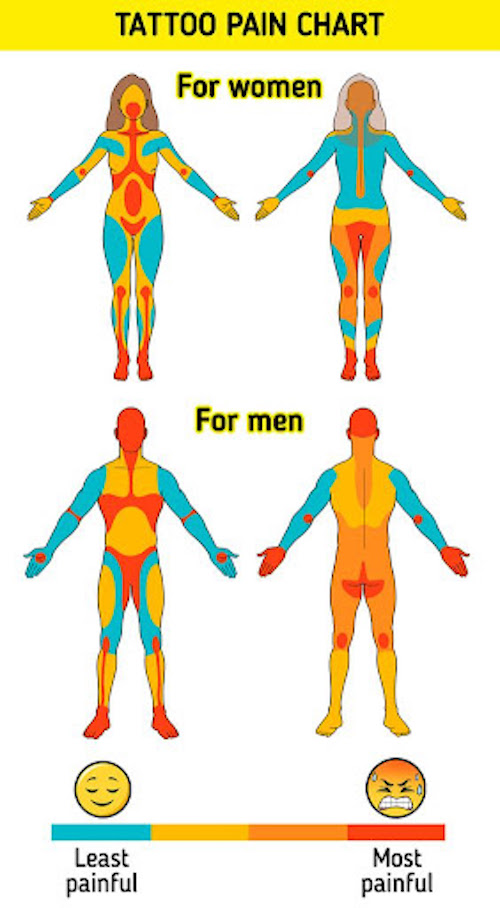
Credit: 5-Minute Crafts/Pinterest
Different tattoo placements are near-identical for both biological sexes. However, there are certain areas where tattoo pain is more intense for females than males and vice versa. Tattoo pain for females is often more intense in the breast and stomach regions than it is for males. However, tattoos done on the back, hip or groin area rank higher on the pain scale for males than for females.
Least Painful Tattoo Spots (Pain Scale Ratings 2-5):
Forearm Tattoo: Pain Scale Ranking - 2-3/10
The outer forearm is known to be one of the least painful spots to get a tattoo for both females and males. It hurts less to get a tattoo on this region of the arm because the area is fairly fleshy with little to no bony regions or nerve endings. While pain is relative, most individuals rank outer forearm tattoos at around a 3 /10 on the pain scale. The pain level will increase with a larger-sized piece or a more intricate design (outlining is typically considered the most painful aspect of the tattooing process).
Outer Arm/Upper Bicep or Shoulder Tattoo: Pain Scale Ranking - 3-4/10
Outer arm (upper bicep) tattoo is one of the least painful tattoo placements for females or males. The outer arm region typically has some fat or muscle, which helps mitigate pain during the tattooing process. An upper bicep tattoo might hurt less for males than females if they build up their bicep muscles (the same positive effects still apply to women, but to a lesser degree). Aside from being one of the least painful tattoo placements available, shoulder tattoos take one of the top spots for the sexiest tattoos for both men and women (a great option for a first tattoo).
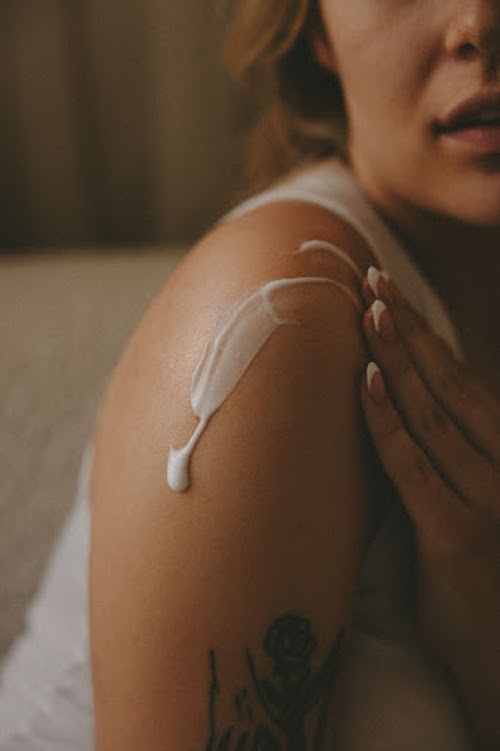
Outer Thigh Tattoo: Pain Scale Ranking - 4-5/10
Upper and outer thigh tattoos are among the least painful spots for a tattoo. Getting a tattoo over your quad muscles or on the top of the thighs will hurt less than tattoo placements along the inner thigh (can have a moderate pain level or be one of the most painful spots to get a tattoo). Outer thigh tattoos tend to rank slightly lower on the pain scale for females than for males (those assigned females at birth tend to store more fat on this portion of their thighs).
Upper or Lower Back Tattoo: Pain Scale Ranking - 5/10
With thicker skin and few nerve endings, upper and lower back tattoos tend to be one of the least painful spots to get a tattoo and rank on the low-moderate end of the tattoo pain scale. These back tattoos tend to be slightly less painful for females than for males. Lower back tattoos are considered to be one of the sexiest tattoo placements for women. A lower back tattoo for women is often referred to as a tramp stamp – which has become popularized again in 2022. Modern tramp stamp designs offer an elevated and updated version of this early ‘00s tattoo trend.

Moderately Painful Tattoo Spots (Pain Scale Ratings 5-7):
Stomach Tattoo: Pain Scale Ranking - 5-7/10
Stomach tattoos have a low-moderate to moderate pain level, depending on your sex assigned at birth, body shape and fat distribution. There are no bony areas on the stomach, so these tattoos hurt less than more painful placements like a ribcage or hip tattoo. A stomach tattoo will be more painful if you have a little extra cushioning on this area or are very thin and the skin on your stomach is particularly taut. Individuals who are females assigned at birth will experience more pain with a tattoo done on the abdominal muscles or the lower stomach. Males assigned at birth tend to have a lower, more moderate pain level when getting a stomach tattoo – whether it’s located on the middle, sides or anywhere else between the ribcage and the hips.
Calf Tattoo: Pain Scale Ranking - 6/10
Calf tattoos done on the sides of your calves should not be too painful compared to the back of the calves or the shins (which are very bony and have many nerve endings). Shin tattoos are among the most painful tattoo placements, so opt for a calf tattoo if you want a piece done on your lower legs without having to ensure severe levels of pain.
Inner Bicep Tattoo: Pain Scale Ranking - 6/10
Inner bicep tattoos involve a moderate pain level and are more painful than an outer bicep tattoo. The inner arm has a thinner skin texture with more nerve endings and less flesh or muscle than the outer bicep. So, if you’re planning to do a sleeve tattoo, stay mindful of the potential pain if you choose to extend it into the inner arm. Consider using a tattoo numbing cream, like Zensa Numbing Cream, for an intricate sleeve – especially if you plan on expanding the piece into a painful spot to get tattooed.
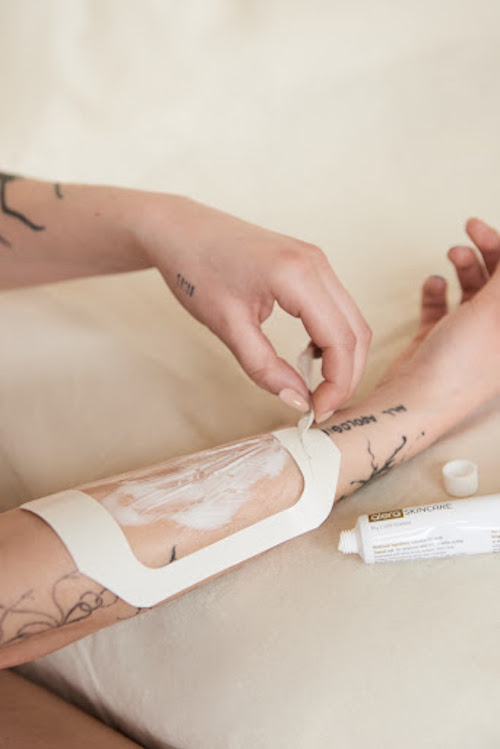
Wrist Tattoo: Pain Scale Ranking - 6/10
The pain level of wrist tattoos varies depending on whether you get them on the outer or inner wrist, how close to the wrist bones you get the tattoo done, the size of the piece and your sex assigned at birth. Outer wrist tattoos will hurt less than inner wrist tattoos, where there are a lot of nerve endings and the skin is particularly thin. Wrist tattoos done closer to the forearm will be less painful than pieces done closer to the wrist bones. The smaller the design, the less your wrist tattoo will likely hurt. Wrist tattoos are generally more painful for females than males. Individuals who are biologically female tend to have smaller, more delicate and bony wrists. Males assigned at birth tend to have more muscle or flesh on their wrists.
Hip Tattoo: Pain Scale Ranking – 7-8/10
Hip tattoos have a fairly high pain level because they are done over your hip bones and an area covered with nerve endings. Females tend to have fleshier hips, so they usually find hip tattoos to hurt less than males do. Individuals who are females assigned at birth typically rank hip tattoos at a 7/10 on the pain scale, while those who are males assigned at birth more often rank hip tattoos as an 8/10 on the pain scale. Outer hip tattoos hurt less than those closer to the groin or private areas.
Buttocks Tattoo: Pain Scale Ranking – 8/10
Some prospective clients may be surprised that this tattoo placement ranks fairly high on the pain scale. While fleshy, the buttocks area contains a high concentration of nerve endings and makes the area more sensitive to pain than some bony regions of the body. These muscles also are likely to clench immediately (and frequently) throughout the procedure. This muscle tension only heightens any pain or soreness experienced during the tattooing process.
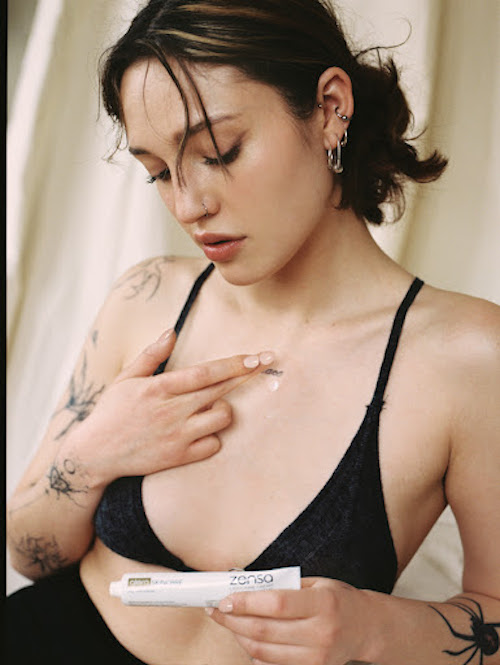
Most Painful Tattoos (Pain Scale Ranking 7-10/10):
Sternum (& Underboob) Tattoo: Pain Scale Ranking – 7-8/10
This tattoo placement is done on the bone that sits between and underneath the breasts (female) or pecs (male). While more popular among women than men, sternum tattoos are considered equally (highly) attractive for both genders. This alluring placement is known to be quite painful and ranks at a 7-8/10 on the pain scale for both females and males assigned at birth. Sternum tattoos sit on a bony area with thinner skin and little to no fat or muscle. So, while they hurt less than some placements like the ribcage, sternum tattoos are among the most painful spots to get a tattoo that still teeters on the edge of a moderate tattoo pain level.
Hands & Finger Tattoos: Pain Scale Ranking – 8/10
Hand and finger tattoos are popular tattoo placement choices. While trendy, know that hand and finger tattoos can be quite painful with the thin skin texture and bony nature of these areas. The outer finger or back of your hands will be the most painful regions to get tattooed. Across genders, hand and finger tattoos typically rate at an 8/10 on the pain scale. However, these tattoos are often small, so the pain will be short-lived.
Elbow Tattoo: Pain Scale Ranking – 8/10
Elbow tattoos or tattoos done in the inner elbow (aka elbow ditch) have a very high pain level compared to other placements on the arm. Two of the three nerves located in your arms pass through the elbow ditch. Additionally, the area is quite bony with very little flesh and thin skin running over it. Individuals of both sexes rate elbow tattoos as a 7-8/10 on the pain scale.
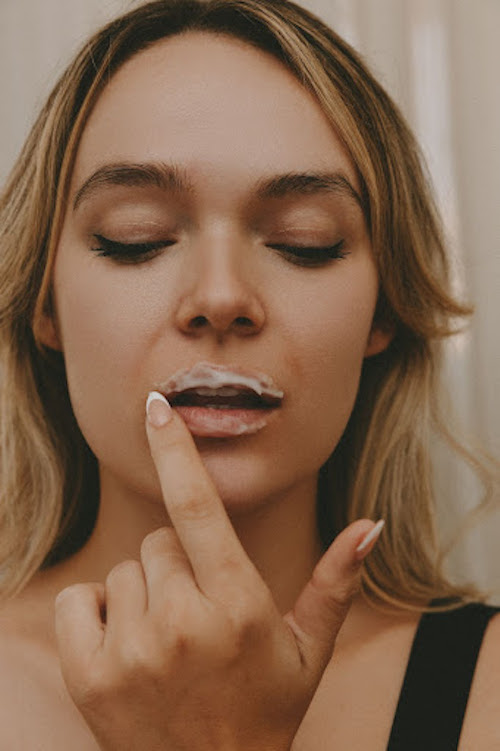
Lip Tattoo: Pain Scale Ranking – 8/10
Not to be confused with lip blushing, lip tattoos are permanent and often refer to inner lip tattoos placed on the gum of your lower lip. Lip tattoos are among the most painful tattoos you can get because of the area’s thin skin texture and its high concentration of nerve endings. These conveniently hidden tattoos rate at around an 8/10 on the pain scale. However, these fairly painful tattoos can fade quickly due to constant mouth movement and moisture in this area. If you’re seeking permanent pigment on the outside of your lips, consider lip blushing (a popular PMU procedure that lasts for 2-3 years) over a traditional lip tattoo. Your lips naturally deflate as you age. So, when you apply a permanent pigment to the presently-plump lips, the lip tattoo can become misaligned with your natural lip shape after several years. For answers to your pressing questions about lip blushing, check out our guide to your lip blushing FAQs.
Knee/Knee Ditch Tattoo: Pain Scale Ranking – 9/10
Pieces done directly on the knee cap or behind the knee are top contenders for the most painful spots to get a tattoo. The sciatica nerve runs through the knee ditch and combined with the thinner skin texture in this area, raises the pain level of a knee tattoo to a 9/10 on the pain scale. For some individuals, especially those who are female assigned at birth, a knee tattoo could escalate to a 10/10 on the pain scale if you have loose skin. However, tattoos done on the sides of the knees are considerably less painful and rank closer to a 7-8/10. Knee tattoos can take particularly long to heal because of the constant rubbing when walking, sitting or lying down.
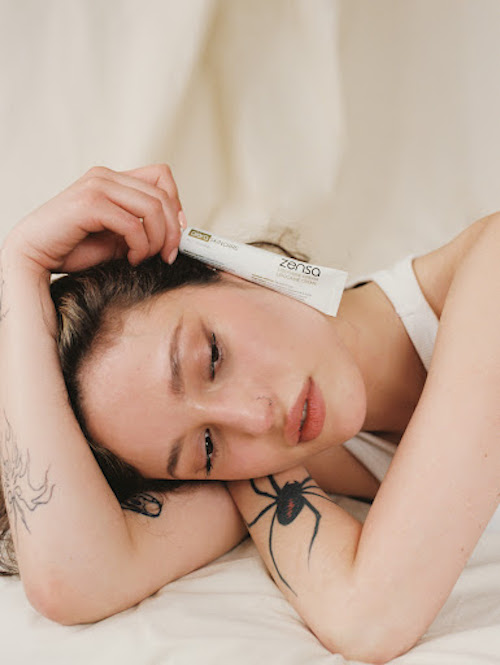
Rib Cage Tattoo: Pain Scale Ranking – 9/10
Rib cage tattoos are well-known to be one of the most painful spots to get a tattoo. On the pain scale, rib cage tattoos rank at an ultra-high 9/10 pain level. The reason for this high ranking is two-fold: The rib cage is a naturally bony area and the skin over your ribs is very thin with little to no muscle or fat to cushion the bone, placing the needle in nearly direct contact with the ribs. Rib cage tattoos are known as one of the sexist tattoos you can get across genders and are a great option for individuals who want tattoos that can be easily concealed before heading out the door.
Spine Tattoo: Pain Scale Ranking – 9/10
Unlike the upper or lower back, the spine is one of the most painful spots to get a tattoo. The spine is a bony area full of nerve endings, which make it particularly sensitive to pain. Spine tattoos generally rank at a 9/10 on the pain scale. So, if you’re getting a full back piece that includes ink injected near the spinal area, consider using a tattoo numbing cream like Zensa Numbing Cream beforehand to minimize the tattoo pain.
Shins, Ankle & Feet Tattoos: Pain Scale Ranking – 9/10
Shin, ankle and feet tattoos are all very bony areas, which, therefore, rank extremely high at 9/10 on the pain scale. All of these areas have ultra-thin skin with several nerve endings and little to no fat covering the bone. The nerves on the feet and ankles are particularly sensitive with next-to-no cushioning to offer a barrier between the needle and the skin.

Collarbone & Shoulder Blade Tattoos: Pain Scale Ranking – 9-10/10
Unsurprisingly, collarbone and shoulder blade tattoo rank (9-10/10) near the top of the pain scale. These tattoos are done right over the bone where there’s little to no fat and can produce pain that radiates through your neck. Come prepared, and use a product like Zensa Numbing Cream to help ease the pain.
Groin & Private Areas: Pain Scale Ranking – 9-10/10
Typically done near the crevice of your thigh, groin tattoos are particularly painful due to the sensitive nature of the area. Between the delicate skin and extremely high amount of nerve endings, any tattoo near the groin is going to rank between a 9-10/10 on the pain scale, depending on how far inwards the ink is placed. Groin tattoos done closer to the hip bones are going to hurt less than ones that are well-acquainted with your private areas. The latter tattoos are located alongside lymph nodes, which increases the pain level and healing time.
Armpit Tattoo: Pain Scale Ranking – 9-10/10
Armpit tattoos are known to be extremely painful. Your armpits are one of the most painful spots to get a tattoo because this area consists of delicate skin with a high volume of nerve endings and is located right above lymph nodes, which increases skin sensitivity, pain and tattoo healing time. Armpit tattoos rank at a 9-10/10 on the pain scale, depending on your personal pain tolerance. Females (assigned at birth) tend to find armpit tattoos slightly more painful than their male counterparts. However, regardless of your biological sex, the armpit is widely considered to be one of the most painful tattoo placements.

How To Minimize Tattoo Pain
Proper tattoo preparation, using a tattoo numbing cream, managing any related stress or anxiety and following your artist’s tattoo after-care instructions are the best ways to minimize pain during and after getting a tattoo. Ensure you arrive at the studio with clean, exfoliated and (potentially) shaved skin. Eat a healthful, hearty meal within 3 hours of your tattoo appointment, drink plenty of water and avoid substances like alcohol or caffeine to keep your body hydrated. Topical anaesthetics can be incredibly helpful to reduce tattoo pain or soreness and can provide you with some mental comfort that the procedure will not hurt too badly.
Zensa Numbing Cream contains 5% lidocaine for maximum-strength pain prevention without compromising pigment retention. Our unique formula does not contain any vasoconstrictors, so Zensa Numbing Cream will not temporarily change your skin’s texture or negatively affect ink settling (the main reason any experienced tattoo artist might be hesitant to use a topical anaesthetic). Zensa Numbing Cream’s numbing effects last for 2-3 hours and can be reapplied on broken skin. Our natural pH formula is suitable for sensitive areas and contains vitamin E to soothe inflammation and minimize any pain or soreness you experience after getting your tattoo.
How To Apply Zensa Numbing Cream For Tattoos
Apply the numbing cream, and allow the proper time for it to absorb into the skin. Zensa Numbing Cream should be applied 30-45 minutes before tattooing. Seal it immediately after application with saran wrap to increase its absorption rate (by 300-500%). Take off the wrapping and gently dab away any excess numbing cream right before stenciling your tattoo.
